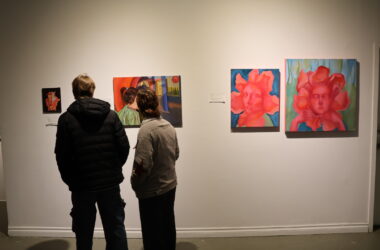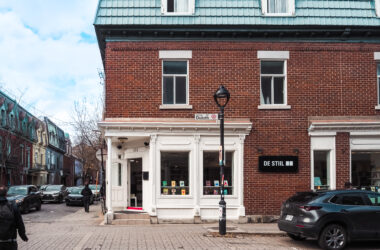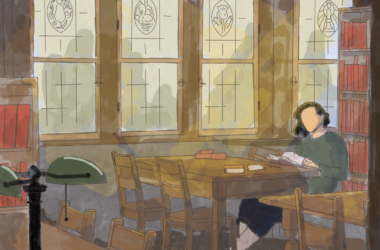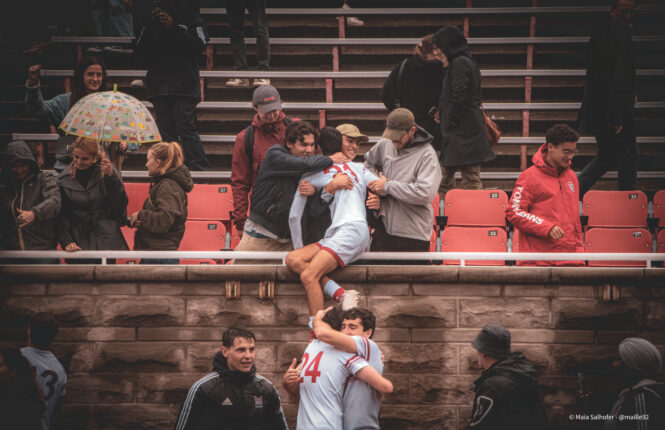If you’re from Winnipeg, you may be familiar with the Rod Peeler bench. For the uninitiated, Rod Peeler is a real estate agent whose distinctive bench ads—plastered with the phrase “I never sleep”—are considered a local legend. When the bench made its cameo appearance in Universal Language, several audience members at the Quebec premiere let out excited gasps of recognition.
“A little narcotic synapse kind of explodes in every Winnipeg brain when they see Rod Peeler,” said director Matthew Rankin in a Q&A after the film.
Details like these are scattered throughout, littering Rankin’s sophomore feature with delightful Canadian in-jokes.
Universal Language is an absurdist fairytale wrapped in ice and snow. The film takes place in a fictional city that blends Winnipeg with Tehran, where two young girls find 500 rials frozen on the sidewalk, embarking on a journey to find an axe to chip it out. Its premise is inspired by beloved Iranian ‘child quest’ films like Where Is the Friend’s House?, which Rankin said he first saw at Cinéma du Parc as a McGill student.
What begins as a simple story, however, quickly evolves into something far more disorienting and surreal, where turkeys are treated like celebrities, Kleenex are a valuable commodity, and characters swap identities. Three disparate stories become interwoven: As the girls attempt to uncover the money, Massoud leads walking tours around the city, and Matthew returns home from Quebec to visit his mother.
“We think of the film as a little bit like the Salvador Dalí lobster telephone, or you could think of it as a Venn diagram, or you could think of it as a Hawaiian pizza. It’s sort of a blending of spheres, and it emerges out of a confluence of three cinematic languages,” said Rankin, citing the influence of Iranian, Winnipeg, and Quebec cinemas on the film.
It seems surprising that such a whimsical narrative would play out against Winnipeg’s brutalist architecture and frigid climate, but the film treats these elements with great affection. Shooting on 16mm, cinematographer Isabelle Stachtchenko draws viewers into the details of the landscape. The soft grain makes corrugated concrete look like pleated velvet and banal details like a streak of black graffiti on a brick wall or a car exiting a spiral parkade become visually engrossing spectacles. Early in the film, one character establishes that the city is divided into the beige district, the grey district, and the brown district. While the film may poke fun at the city’s muted shades, it also reveals how the more carefully you look, the more idiosyncrasies can be found.
The film’s ensemble is made up of friends and family, who each collaboratively shaped the film in their own ways. “I’m a big believer that you should make films with your friends,” said Rankin.
In the first scene, a temperamental school teacher (Mani Soleymanlou) reminds his students that he isn’t like other authority figures—He wears an earring! He’s played the electric guitar for them more than once!—establishing a comically earnest tone that is threaded consistently throughout. The two young girls, Negin (Rojina Esmaeili) and Nazgol (Saba Vahedyousefi), also stand out, both charmingly deadpan and sincere. Their high-stakes quest is absorbing and nostalgic, so I was slightly disappointed that the parallel story of Matthew ended up dominating the narrative.
Played by Rankin himself, Matthew’s storyline introduces an intriguing semi-autobiographical element to the film, but his characterization lacks the same compelling, idiosyncratic qualities the young cast members share. At times, the melancholic tone of Matthew’s journey home seems to be in conflict with the rest of the narrative, tonally inhabiting a different world from the children. Although the film’s central theme is convergence, this shift suggests that generational divides might be more difficult to reconcile. Regardless, Rankin’s blending of disparate elements has created a world that is entirely singular and unique. Through the howling wind and crunching snow, Universal Language bridges impossible-seeming gaps between ideas and places.
Universal Language is in theatres across the country.








